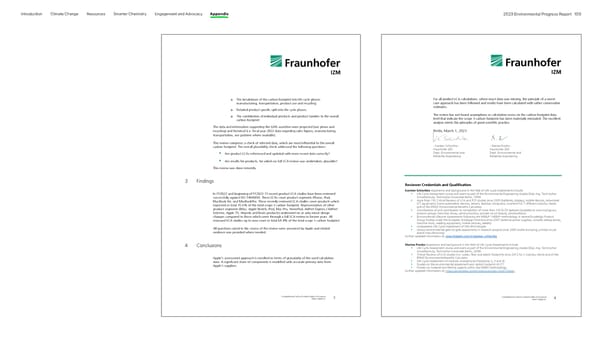Introduction Climate Change Resources Smarter Chemistry Engagement and Advocacy Appendix 2023 Environmental Progress Report 103 o The breakdown of the carbon footprint into life cycle phases For all product LCA calculations, where exact data was missing, the principle of a worst- case approach has been followed and results have been calculated with rather conservative manufacturing, transportation, product use and recycling o Detailed product specific split into life cycle phases estimates. o The contribution of individual products and product families to the overall The review has not found assumptions or calculation errors on the carbon footprint data level that indicate the scope 3 carbon footprint has been materially misstated. The excellent carbon footprint analysis meets the principles of good scientific practice. The data and information supporting the GHG assertion were projected (use phase and Berlin, March 1, 2023 recycling) and historical (i.e. fiscal year 2022 data regarding sales figures, manufacturing, transportation, use patterns where available). This review comprises a check of selected data, which are most influential to the overall - Karsten Schischke - - Marina Proske - carbon footprint. The overall plausibility check addressed the following questions: Fraunhofer IZM Fraunhofer IZM Dept. Environmental and Dept. Environmental and Are product LCAs referenced and updated with more recent data correctly? Reliability Engineering Reliability Engineering Are results for products, for which no full LCA review was undertaken, plausible? This review was done remotely. 3 Findings Reviewer Credentials and Qualification Karsten Schischke: Experience and background in the field of Life Cycle Assessments include In FY2022 and beginning of FY2023 11 recent product LCA studies have been reviewed Life Cycle Assessment course and exam as part of the Environmental Engineering studies (Dipl.-Ing. Technischer Umweltschutz, Technische Universität Berlin, 1999) successfully against ISO 14040/44. These LCAs cover product segments iPhone, iPad, more than 150 Critical Reviews of LCA and PCF studies since 2005 (batteries, displays, mobile devices, networked MacBook Air, and MacBookPro. These recently reviewed LCA studies cover products which ICT equipment, home automation devices, servers, desktop computers, inverters) for 7 different industry clients represent in total 35.6% of the total scope 3 carbon footprint. Representatives of other and of the EPEAT Environmental Benefits Calculator product segments (iMac, Apple Watch, iPod, Mac Pro, HomePod, AirPort Express / AirPort Coordination of and contribution to compilation of more than 100 ELCD datasets (available at www.lca2go.eu; Extreme, Apple TV, Airpods and Beats products) underwent no or only minor design product groups: hard disk drives, semiconductors, printed circuit boards, photovoltaics) Environmental Lifecycle Assessments following the MEEuP / MEErP methodology in several Ecodesign Product changes compared to those which went through a full LCA review in former years. All Group Studies under the European Ecodesign Directive since 2007 (external power supplies, complex settop-boxes, reviewed LCA studies up to now cover in total 68.4% of the total scope 3 carbon footprint. machine tools, welding equipment, mobile phones, tablets) comparative Life Cycle Assessment of SIM technologies All questions raised in the course of the review were answered by Apple and related various environmental gate-to-gate assessments in research projects since 2000 (wafer bumping, printed circuit evidence was provided where needed. board manufacturing) Further updated information at: www.linkedin.com/in/karsten-schischke Marina Proske: Experience and background in the field of Life Cycle Assessments include 4 Conclusions Life Cycle Assessment course and exam as part of the Environmental Engineering studies (Dipl.-Ing. Technischer Umweltschutz, Technische Universität Berlin, 2009) Critical Reviews of LCA studies incl. water, fiber and plastic footprints since 2012 for 2 industry clients and of the EPEAT Environmental Benefits Calculator Apple’s assessment approach is excellent in terms of granularity of the used calculation Life Cycle Assessment of modular smartphones (Fairphone 2, 3 and 4) data. A significant share of components is modelled with accurate primary data from Studies on the environmental assessment and carbon footprint of ICT Apple’s suppliers. Studies on material and lifetime aspects within the MEErP methodology Further updated information at: https://de.linkedin.com/in/marina-proske-74347164/en Comprehensive Carbon Footprint Letter of Assurance Comprehensive Carbon Footprint Letter of Assurance 3 4 Client: Apple Inc. Client: Apple Inc.
 Apple Environmental | Immersive Page 102 Page 104
Apple Environmental | Immersive Page 102 Page 104